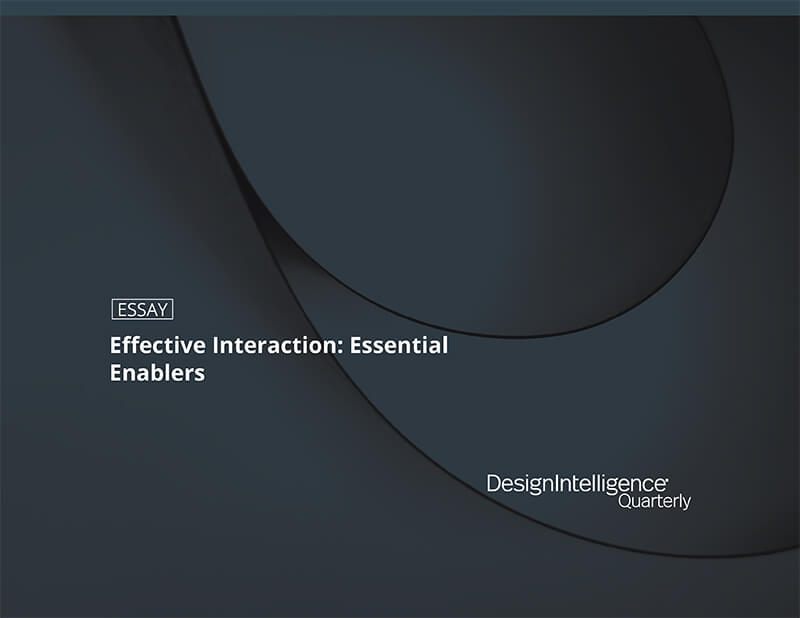Effective Interaction: Essential Enablers
by Dave Gilmore
President and CEO,
DesignIntelligence
June 30, 2021
I’ve been pondering the theme of human interaction for the past several months, trying to understand the heart of it. Like so many words in our vocabulary, we use them (and sometimes abuse them) without grasping the meaning and intent resident within them.
Interaction is an idea possessing the power to connect and transform. It speaks to relationships, as interaction requires more than one party to function. When people come together, they interact by giving and receiving. They exchange signals, content and tangibles. Our interactive relating, one to another, generates all manner of outcomes.
Constructive interaction results in positive relational, emotional, functional and material outcomes. Destructive interaction so often yields diminishment, erosion, separation and a litany of aberrant outcomes. Sometimes what we label as “destructive interaction” is in fact a precursor to constructive outcomes. Sometimes healthy conflict between people exposes mutually recognized contributions that inhibit positive interaction and its close cousin, collaboration.

Over the course of my career, I’ve assembled an inventory of essential enablers to effective interaction. This list is by no means exhaustive but has served me well in myriad situations where the absence of these techniques might have resulted in less glowing outcomes. Here are three:
Consciously Open Receptors
God had great wisdom in giving us two eyes, two ears, two nostrils … and one mouth. Our receptors outnumber our transmitters. Why then do we so often neglect the input of our receptors and talk-shout-scream with our mouths and facial expressions when interacting with others?
In a front-of-mind posture, when I consciously lean into listening and fully observe those with whom I’m interacting, the results are far more constructive and meaningful than when I don’t. Conscious reception signals acceptance and intentionality to others. And who doesn’t want to be accepted and shown the respect of full engagement?
De-Agendizing
A new word. Perhaps awkward, but effective. Entering an interaction with no pre-set agenda is the opposite of what most management efficiency gurus would suggest. But efficiency isn’t always the objective. Sometimes such counter-intuitive actions transform relationships and yield better outcomes.
Meeting with others often requires a structure, usually in the form of an agenda to guide conversation and intended outcomes. But “de-agendizing” has less to do with structure and more to do with consciously setting aside a predetermined position to defend or a personal objective. When we deactivate such posturing and allow an organic freedom of mutual exchange in the interaction, the outcomes are given the liberty to yield multi-dimensional benefits for all participants.
Active Listening
A time-tested practice, active listening extends and enables consciously open receptors. To actively listen involves giving timely feedback within the context of dialogue. It reinforces what was heard yet remains open to being corrected if not right. Active listening focuses on understanding the other party’s input and contributions, as well as the intention and motivation behind what they are expressing — the unsaid, “between the lines” information.
Active listening is a forward-leaning mental posture that seeks to put aside intrusive distractions when interacting with others. It’s concentrates ear-to-ear, eye-to-eye and mind-to-mind attention to the language spoken and unspoken, seeking the meaning that accompanies it all.
Imagine This
Imagine how the discipline of business development might be radically altered if those pursuing new client relationships applied these three enablers to client interactions. What clients desire above all else is to be heard and understood. And yet, far too many servicers are inclined to promote and present. It’s strange, if not disturbing, to witness seasoned, intelligent, talented professionals so often cast off listening in favor of speaking at their clients. Their clients are hoping for inquisitive questions and feedback that indicates meaningful listening. What they get instead is promotional posturing and a parade of portfolio victories.
Usually, in a move to mitigate the confusion of multiple firms self-promoting their “exceptional” design capabilities, these bewildered clients shift the decision-making to a Request For Proposal process, appoint a vetting committee and run through the paces of organized comparing and contrasting. In a sea of sameness where no one is listening, they seek differentiation — good or bad. Most of these investors and owners are savvy enough to discern the difference between pretense and authenticity, but what they want most is positive, meaningful interaction with built environment industry professionals who have their client’s interests in mind. Those who can offer such client focus are the exception.
Realms of Possibility
How might you approach each interaction with client prospects while applying these three enabling listening techniques? How might things change in that interaction if you consciously exercised all your receptors? What might result if you didn’t come with an agenda to advance your prospects or close a deal? What if you simply approached the interaction with curious questions seeking to understand the who, why, what and more of the client’s perspective? How might everything change if you listened purposely and intentionally — really listened — to those with whom you interacted?
Professional interaction begins within the firm. Engaging one another in new and meaningful ways might be the best place to start. If we truly seek to understand rather than be understood, every interaction will suddenly mean more. Imagine what your relationships might look like if those with whom you’re interacting were convinced you cared and wanted to understand. If you could feed back that understanding with words that mattered. Might this be the basis of authentic collaboration?
Introspection, when properly shared and responded to, gives access to a new dimension of honesty. This kind of honesty manifests itself as open vulnerability. It openly admits lacking everything it needs and invites contributions by others. Honest introspection illuminates shadowed areas of understanding and helps us achieve with others what we couldn’t produce alone.
When my contribution or thinking, incomplete as that may be, is combined with yours and the caring inputs of the many others with whom we interact, all are bettered, all move toward completion, all find the fullness we’ve been seeking. This kind of multi-dimensional interaction serves as the basis for actionable collaboration and offers the safety and strength of mutual interdependence. This “lean on me/lean on each other” dynamic results in synergy and sustainability not possible otherwise.
Dave Gilmore is president and CEO of DesignIntelligence


